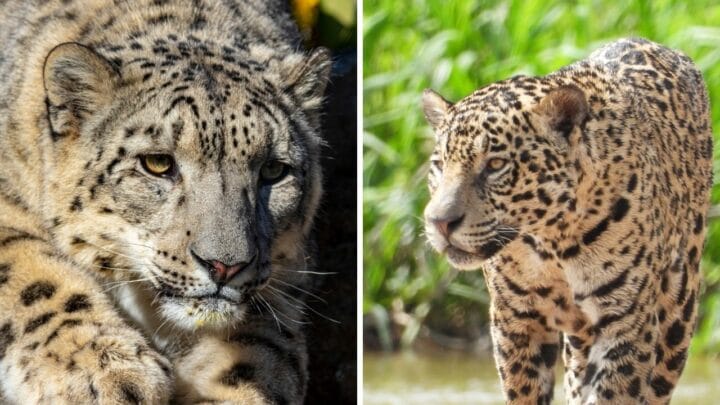Big cats are already spectacular in appearance, but now imagine them with white coats and big blue eyes? And I’m not talking about the Photoshopped images we find on the internet.
White big cats, like leopards and jaguars, really do exist, although they are exceptional and rare. Read on to find out more about these amazing natural anomalies.
Are there any albino leopards or jaguars?
All types of big cats can suffer from albinism, a recessive gene leading to pigmentation absence. Some also carry the leucism genes, a condition of partial pigment loss. The chinchilla mutation occurs when the color pigment is only present in the hair follicle tips, giving animals a pale, discolored appearance.
Are There Known Cases of Albino Leopards
The first known instance of white or albino leopards was recorded by Richard Lydekker in 1910.
He described them as pale creamy white with blue eyes and very faint markings, and he stated that they had been spotted in India, southern China, and Zimbabwe.
A few decades later, in 1953, a report of a leopard with no black markings surfaced in a publication called “The Field.” However, it is unlikely that this was a case of albinism, as aside from lacking melanistic traits, the leopard was typically colored.
Between 1935 and 1960, a white leopard from Mozambique was housed at the Central Park Zoo, although it is said that its markings could be seen in the right light.
Three other cases of white leopard cubs have been reported over time in the Cheyenne Mountain Zoological Park, the Rome Zoo, and the Wildlife World Zoo, respectively.
However, these leopards were either fully or partially albino at birth but generally changed color as they grew older, turning light grey and developing faint markings.
Although it is proven that albino leopards exist, how many there are in the wild is unknown. Leopards are elusive and will stay as far from humans as possible.
Are There Known Cases of Albino Jaguars
While reports of albino jaguars are difficult to come by, we know that, given their genetic make-up, they can suffer from albinism or leucism, just like other big cats.
In the late 1700s, a Spanish naturalist called Félix de Azara described a jaguar so pale it’s rosettes could only be seen in bright sunlight.
In Paraguay, further cases of light grey and partially albino jaguars have been reported since at least the early 1800s.
In 2012, twin white jaguar cubs were born in a zoo in Germany to a typically spotted father and a jet-black mother.
However, given the relatively old age of their parents, it is undetermined whether they suffered from a recessive gene or if their discoloration was due to a condition known as fever coat.
Fever coat results from fluctuating temperatures in the womb that can cause a lack of melanin in newborn cubs. As they grow older, they develop their standard colors.
As with leopards, it is unknown how many albino jaguars exist in the wild.
How to Distinguish between Leopards and Jaguars
When researching big cats, the names they go by can be confusing, which is why I want to clarify the difference between leopards and jaguars before continuing.
White big cats are almost always called white panthers, making it difficult to distinguish which specific animal is referred to in case studies. The same goes for melanistic leopards and jaguars that are entirely black.
The term panther is used interchangeably to describe leopards, jaguars, and cougars. However, it is actually the overarching name used to describe any big cat with black markings.
It refers to the genus Panthera of the family Felidae overall and not a particular cat species.
Leopards and jaguars are distinct cat species, known as Panthera pardus and Panthera onca, respectively.
Leopards are found in sub-Saharan Africa and parts of Asia and Russia. Jaguars, in turn, are native to Central and South America.
Both cats have rosette markings, and they look pretty similar, but leopards are slightly smaller than jaguars.
Furthermore, both species are endangered, as their natural habitats have been diminished due to industrialization. They have also been eradicated by hunters.
Frequently Asked Questions about The Presence of Albino Leopards or Jaguars
How are animals born with albinism?
Albinism is a hereditary trait passed down from parents with a recessive gene. Babies are then born with cells that cannot produce color pigment. In cats, albinism most often presents with a white coat and pale blue eyes.
Are there jaguars in the United States?
Historically, wild jaguars inhabited parts of the United States, but over the last century, they have become exceedingly rare, and very few sightings have been noted.
Do snow leopards have albinism?
Snow leopards are a specific breed of the Panthera genus native to Central and South Asia. Their white or grey fur results from an evolutionary need to camouflage in their snowy environments and is not a consequence of a gene mutation.
Conclusion
While albino big cats are breathtaking to behold, unfortunately, this rare genetic mutation does not serve them well in the wild.
White coats make it very difficult for panthers to be inconspicuous, which means they have a lesser chance of survival and passing on their distinct coloring.
Furthermore, white big cats are prized by hunters, further reducing their chances of a long life.


